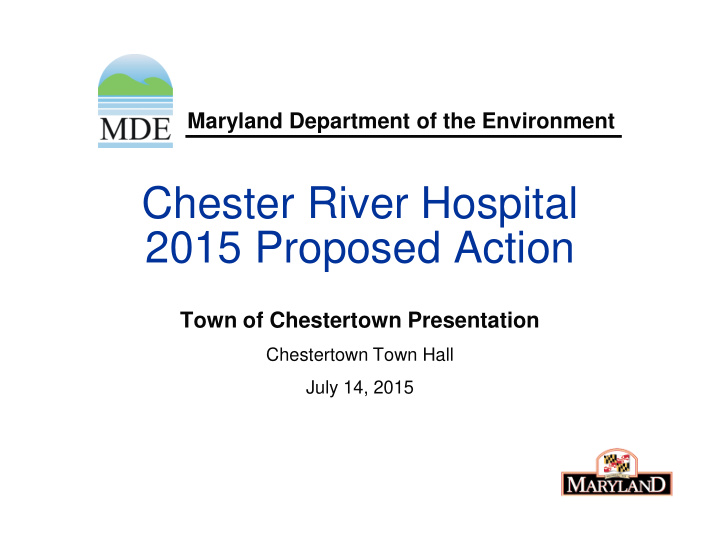



Maryland Department of the Environment Chester River Hospital 2015 Proposed Action Town of Chestertown Presentation Chestertown Town Hall July 14, 2015
Outline • Purpose of Tonight’s Meeting • Regulatory Overview • Site Characterization – Release Estimates – Release Estimates – Site Maps • Surfactant Remediation Summary – Pilot Test – Proposed Plan
Purpose of Tonight’s Meeting • A discussion of the remediation plan • We are all working together to reach the common goal of protecting public health, including the Town’s drinking water supply • MDE is prepared to approve the proposed plan with modifications • MDE believes the plan is safe • MDE believes the plan will afford greater protection than the pump and treat system alone
Regulatory Overview • The goal is to remediate a release of oil to protect public health and the environment, including public drinking water sources • The Oil Control Program ensures that responsible parties assess and remediate their environmental liabilities and that assess and remediate their environmental liabilities and that they monitor their progress • The Oil Control Program reviews and approves work plans submitted by responsible parties to achieve this goal • At times, the Oil Control Program modifies responsible party plans as part of the approval process to enhance protection of public health and the environment
Site Characterization Overview • Release Estimates • Site Maps
How much Oil was Released? • Case was opened in 1987 • Initial investigations concentrated on UST testing and removal/replacement • There is no reliable way to know for certain • Between 1991 and 2011, over 83,000 gallons of heating oil was recovered as LPH • Additional unquantifiable amounts have been recovered through groundwater extraction and reduced through biodegradation • The evidence from the monitoring well network provides the best picture
Approximate Town Well Locations
• Indicates location where LPH have historically been detected
Pilot Test Summary • Pilot test in summer 2014 • Four wells tested • Surfactant was successfully removed and residuals degraded during the three month post monitoring period • TPH-DRO levels increased during the test, which is indicative of surfactant working • Evidence of surfactant observed in treatment system
Proposed Plan Overview • The pump and treat system will remain on during the entirety of the remediation plan implementation • A 275-gallon mixture of Ivey-sol (surfactant) and potable water will be injected into several wells and left to soak for 48 hours (Push events) • A pump will be used to extract liquids from the well (approximately 825 to 1,375 gallons) until there is no sign of surfactant presence remaining (Pull events) events) • This process will be repeated at each well within Priority Zone 1 until TPH- DRO results are at or near laboratory detection limits. Once this milestone is achieved, the process will be repeated for each of the remaining Priority Zone wells • The plan predicts it will take three to six months to complete the remediation phase • The monitoring phase will take at least one year, and potentially longer, depending on the data collection
Proposed Plan Overview, cont. • Monitoring Plan – Monthly gauging of all monitoring and recovery wells – Monthly sampling for TPH-DRO of 11 monitoring wells (MW15, MW16, MW19, MW20, MW24, MW33, MW34, MW35, MW48, MW49, MW50) – Quarterly sampling of all monitoring and recovery wells for TPH-DRO, VOCs, and surfactants – Monthly, all laboratory and field testing results that were performed during the implementation of the Priority Zones will be provided to MDE • Post-remedial Monitoring – The pump and treat system will be on until surfactants are not detected – MDE will issue written notice when the system may be turned off and the post-remedial monitoring period may begin – Year begins when surfactants are no longer detected – The post-remedial monitoring may be extended pending review of the data
Key Points • The pump and treat system is not the longterm solution, but can be used for short term goals • The modified version of the Hospital’s plan that MDE is prepared to approve will lead to a significant amount of residual LPH being removed in a safe manner • • The net benefit will reduce the longterm risk to the Town’s wells The net benefit will reduce the longterm risk to the Town’s wells • Once completed, there will be a minimum observation time of over a year before any final case closure decisions are made • If the data indicates more remediation is warranted, then that is where the MDE will direct the case • MDE is committed to continued communication with the Town
For More Information Website http://www.mde.state.md.us/programs/Land/OilControl/Re mediationSites/Pages/Programs/LandPrograms/Oil_Contro l/RemediationSites/index.aspx Or http://bit.ly/MDEOCPRemediationSites
Maryland Department of the Environment Horacio Tablada Horacio Tablada Christopher Ralston 410-537-3442 chris.ralston@maryland.gov 1800 Washington Boulevard | Baltimore, MD 21230-1718 410-537-3000 | TTY Users: 1-800-735-2258 www.mde.maryland.gov
Recommend
More recommend